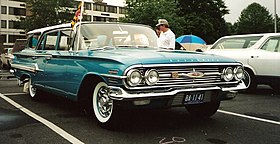Chevrolet Nomad
| Chevrolet Nomad | |
|---|---|
 |
|
| Overview | |
| Manufacturer | Chevrolet (General Motors) |
| Production | 1955–1961 1968–1972 |
| Layout | FR layout |
| First generation | |
|---|---|
 |
|
| Overview | |
| Production | 1955–1957 |
| Body and chassis | |
| Body style | 2-door/2-bench seats station wagon(1955–1957) |
| Platform | A-body |
| Powertrain | |
| Engine | 265 cu in (4.3 L) V8 283 cu in (4.6 L) V8 |
| Dimensions | |
| Wheelbase | 115 in (2,921.0 mm) |
| Length | 201 in (5,105.4 mm) |
| Second generation | |
|---|---|
 |
|
| Overview | |
| Production | 1958–1961 |
| Body and chassis | |
| Body style | 4-door/5-seat station wagon |
| Platform | GM B platform |
| Powertrain | |
| Engine | 265 cu in (4.3 L) V8 283 cu in (4.6 L) V8 |
| Third generation | |
|---|---|
 |
|
| Overview | |
| Production | 1968–1972 |
| Body and chassis | |
| Body style | 4-door/5-seat station wagon |
| Platform | GM A platform (RWD) |
The Chevrolet Nomad was a station wagon model made off and on from 1955 to 1972, and a Chevy Van trim package in the late 1970s and early 1980s, produced by Chevrolet. The Nomad is best remembered in its two-door 1955–57 form, and was considered a halo model during its three-year production as a two-door station wagon.
The two-door Nomad differed from other station wagons of the era by having unique styling more reminiscent of a hardtop sedan than that of a standard station wagon. Chevrolet shared this body with its sister Pontiac, which marketed their version as the Pontiac Safari.
The Nomad's unique design had its roots in a General Motors Motorama show car of the same name that was based on the Corvette. The Concept was introduced at the GM Motorama in 1954 as one of Head Stylist Harley Earl's "dream cars". It followed the introduction in 1950 of the Ford Country Squire two door station wagon.
GM approved production of the vehicle if the design could be transferred to its standard model, because top GM brass felt that they could sell more models if it were attached to the popular Bel Air model. In fact, following the product debut in 1955, it was not uncommon for the car to be referred to as the Chevy "Bel Air Nomad".
The Nomad's relatively short wheelbase and overall length in comparison to Chevrolet coupes, sedans and station wagons of the same time period show modern similar characteristics to hatchbacks in later years. The platform used was GM's smallest, a two-door bodystyle with a rear bench seat that folded down to accommodate cargo, and a two-piece tailgate with a glass upper portion that swung up, with a tailgate that folded down were the features that made the Nomad very popular. It also shares many visual characteristics with the 1970 Range Rover Classic without the extended ground clearance and four-wheel drive.
Between 1968 and 1972 the names Nomad and Nomad Custom were applied to the lowest-priced Chevelle four-door station wagon model, below the Chevelle Greenbrier, Chevelle Concours, and Chevelle Concours Estate.
...
Wikipedia
